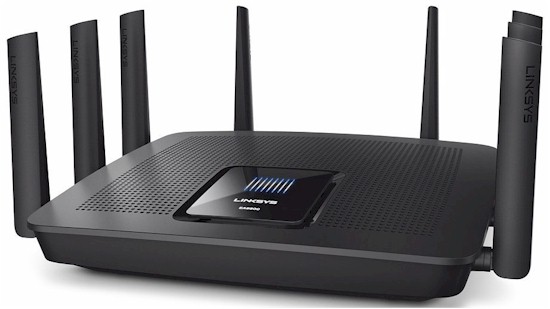
| At a glance | |
|---|---|
| Product | Linksys Max-Stream AC5400 MU-MIMO Gigabit Router (EA9500) [Website] |
| Summary | AC5300 class Broadcom-based tri-band router with two 4×4 MU-MIMO enabled 5 GHz radios. |
| Pros | • Eight gigabit LAN ports • MU-MIMO that works • Smart Connect band steering |
| Cons | • Undistinguished routing feature set • MU-MIMO doesn’t work as well as QCA-based products • Smart Connect works only between 5 GHz radios |
Typical Price: $170 Buy From Amazon
Introduction
Linksys’ EA9500 Max-Stream AC5400 MU-MIMO Gigabit Router is the first of a second round of tri-radio routers based on Broadcom’s 4×4 MU-MIMO chipset. Unlike the first round that included NETGEAR’s R8500 Nighthawk X8 [reviewed] and ASUS’ RT-AC5300 [reviewed], the new routers from Linksys and TP-LINK decided to adopt Broadcom’s official 5.4 Gbps rating, hence their AC5400 moniker vs. NETGEAR and ASUS’ AC5300. To avoid confusion, I’ll be classing them all as AC5300, since that was the first to be used.
At any rate, neither the EA9500 nor TP-LINK’s Archer C5400 that started shipping earlier this week offer anything new. All use the same 4×4 Broadcom chipset with tri-radio architecture. The main difference is in number of LAN ports, port aggregation support, antenna configuration and whether MU-MIMO is supported. Table 1 summarizes these differences. Kudos to Linksys for being the first to market with an AC5300 class MU-MIMO router that actually supports MU-MIMO!
| Linksys EA9500 | TP-LINK Archer C5400 | NETGEAR R8500 | ASUS RT-AC5300 | |
|---|---|---|---|---|
| LAN ports | 8 | 4 | 6 | 4 |
| Aggregation | N | N | Y | Y |
| Antenna | 8 external attached | 8 external attached | 4 external attached 4 internal |
8 external RP-SMA |
| MU-MIMO Support | Y 2 STA per radio |
N | Beta | Alpha |
Table 1: Component summary and comparison
If you want the meanest-looking, most physically imposing router to impress your friends, you’ll want ASUS’ RT-AC5300. But if you’d rather have an eight-antenna router that doesn’t look like one, you’ll like the EA9500. Keeping antennas off the front panel makes for a much cleaner design, to my eye. Of course a big black slab with eight things sticking up from it is hardly a recipe for high WAF.
The front panel callout diagram below describes the unique front panel lighting. I didn’t verify the MU-MIMO light feature because I had to remove the panel to directly connect to the radio for MU-MIMO testing.
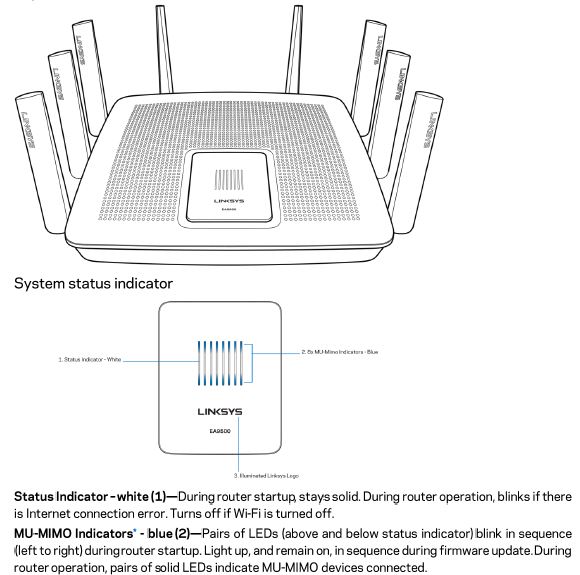
EA9500 front panel callouts
The rear panel has one each USB 2.0 and 3.0 ports, eight Gigabit Ethernet LAN ports and one WAN port. Port aggregation is not supported, but at least every port has its own link and activity LEDs that should be called out in the diagram. The right side of the router sports Wi-Fi Protected Setup (WPS) and wireless on/off switches.
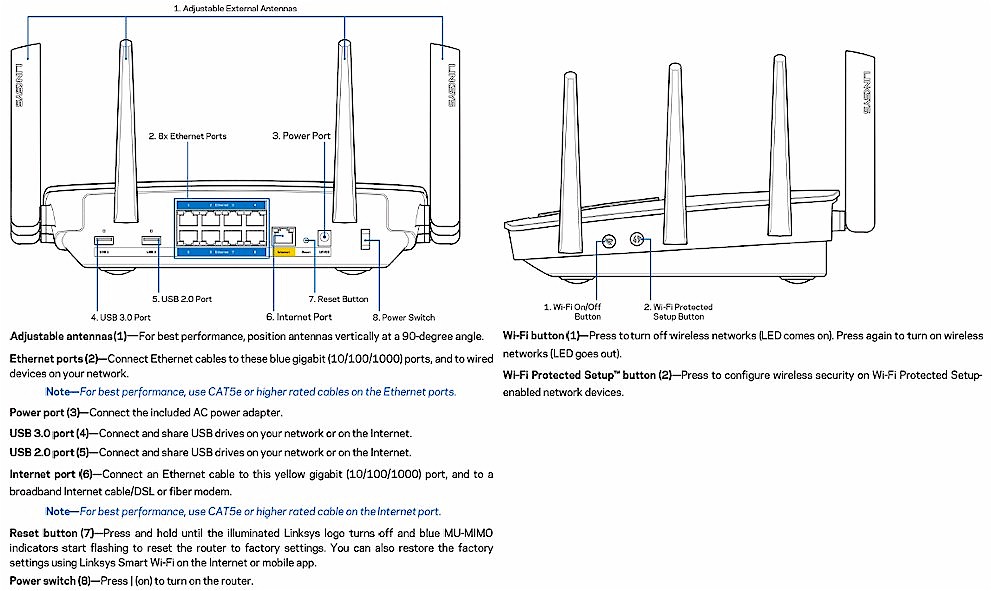
EA9500 side and rear panel callouts
Inside
Linksys released the FCC internal pictures, so major surgery wasn’t required to perform component analysis. The shot below is with the top, internal cover support frame and heatsinks removed.
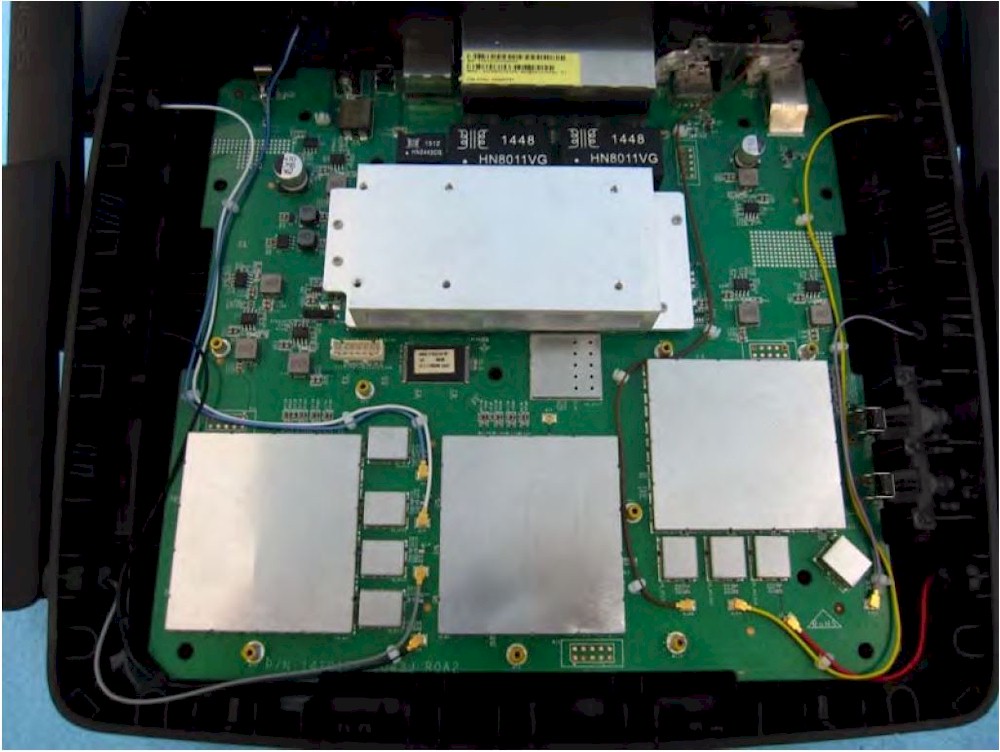
Linksys EA9500 inside
Stripping off all the RF can tops shows the CPU / switch section at top, 5 GHz high-band and 2.4 GHz radios at bottom left and 5 GHz low band radio at lower right. The 5 GHz high-band and 2.4 GHz radios share the left side antennas while the 5 GHz low band has the right four antennas all to itself.
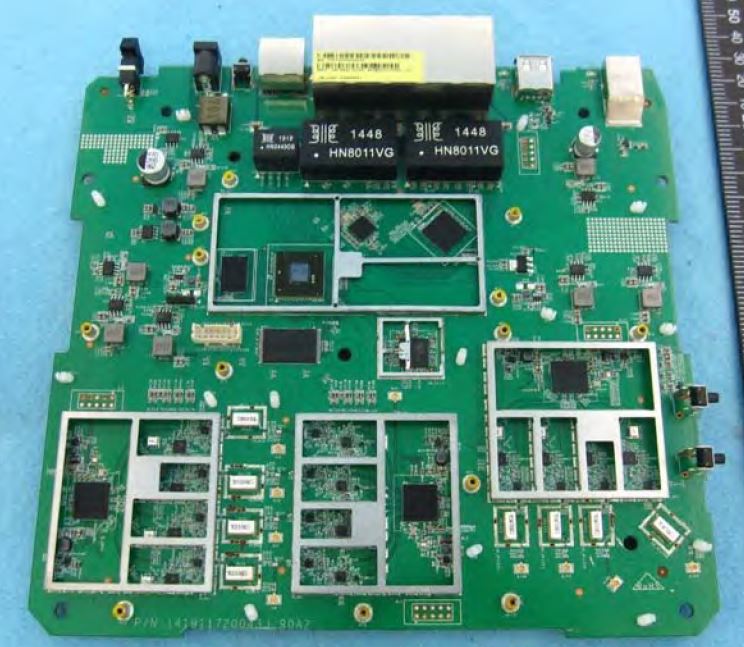
Linksys EA9500 board
Table two summarizes the key components for the EA9500 and NETGEAR and ASUS AC5300 routers. The processor and radio components are all the same. The Linksys is the only one of the three with only 256 MB of RAM.
| Linksys EA9500 | NETGEAR R8500 | ASUS RT-AC5300 | |
|---|---|---|---|
| CPU | Broadcom BCM4709C0KFEBG dual-core @ 1.4 GHz | Broadcom BCM4709C0KFEBG dual-core @ 1.4 GHz | Broadcom BCM4709C0KFEBG dual-core @ 1.4 GHz |
| Switch | in BCM4709C0KFEBG & BCM53125 | in BCM4709C0KFEBG & BCM53125 | Realtek RTL8365MB or in BCM4709C0KFEBG |
| RAM | 256 MB | 512 MB | 512 MB |
| Flash | 128 MB | 128 MB | 128 MB |
| 2.4 GHz Radio | – BCM4366 4×4 2.4/5G single chip 802.11ac SoC – Skyworks SE2623L 2.4 GHz power amp (x4) |
– BCM4366 4×4 2.4/5G single chip 802.11ac SoC – Skyworks SE2623L 2.4 GHz power amp (x4) |
– BCM4366 4×4 2.4/5G single chip 802.11ac SoC – Skyworks SE2623L 2.4 GHz power amp (x4) |
| 5 GHz radio | – BCM4366 4×4 2.4/5G single chip 802.11ac SoC – RFMD RFPA5542 5 GHz PA module (x4) NOTE: There are two 5 GHz radios. |
– BCM4366 4×4 2.4/5G single chip 802.11ac SoC – RFMD RFPA5542 5 GHz PA module (x4) NOTE: There are two 5 GHz radios. |
– BCM4366 4×4 2.4/5G single chip 802.11ac SoC – RFMD RFPA5542 5 GHz PA module (x4) NOTE: There are two 5 GHz radios. |
| PCIe | PLX Technology PEX8603 3-lane, 3-port PCIe switch | PLX Technology PEX8603 3-lane, 3-port PCIe switch | ASMedia ASM1182e |
Table 1: Component summary and comparison
Check the gallery for more inside photos and commentary.
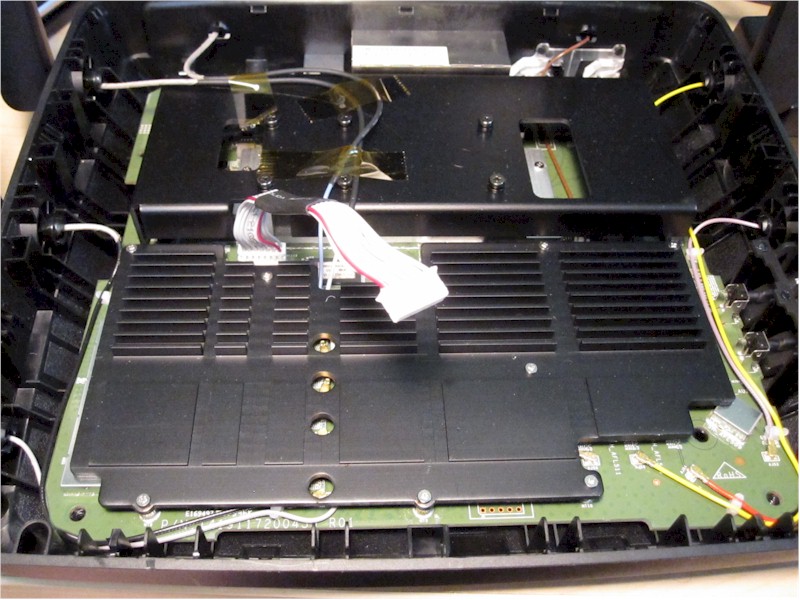
Photo shows the heatsink plates in place, The dangling connector plugs into the LED panel on the top cover

Removing the heatsinks more clearly reveals the major assemblies. CPU and switch top center, 5 GHz high-band and 2.4 GHz radios at bottom left and 5 GHz low band radio at lower right.

RF tops removed reveal the Broadcom components; BCM4709C0KFEBG dual-core CPU and BCM4366 4×4 radio SoCs.
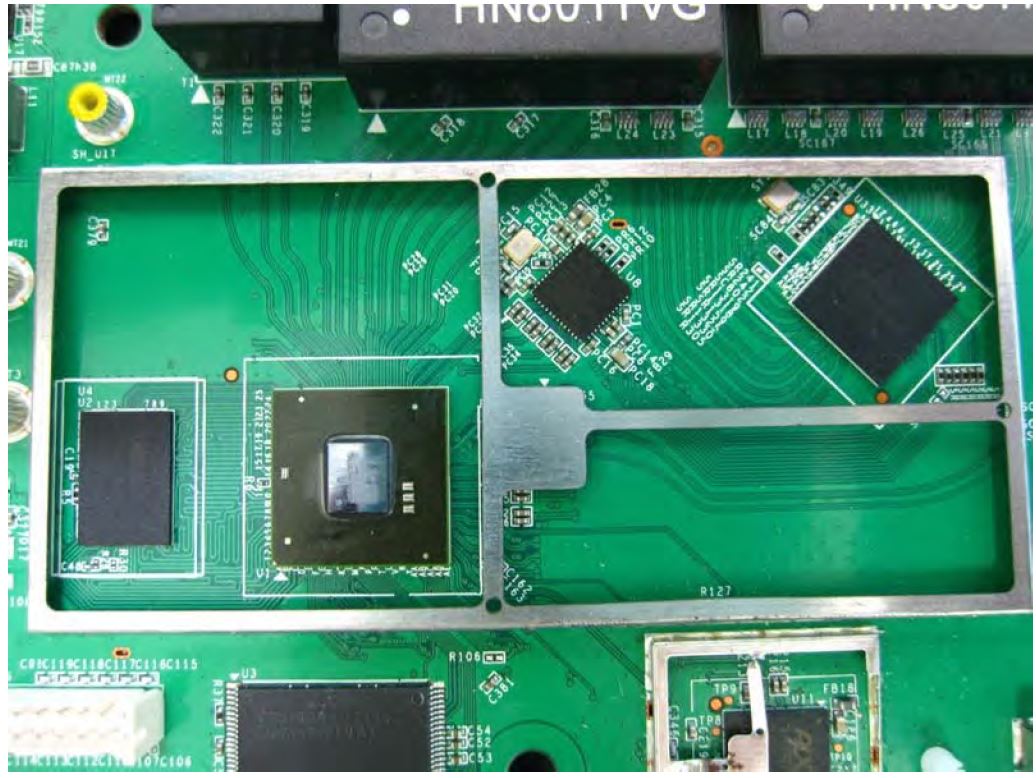
You can’t make out part numbers in this photo, but other photos allowed proper ID. Top row from left: RAM, BCM4709C0KFEBG CPU, some sort of Broadcom switch companion chip, Broadcom BCM53125 switch. Bottom row shows flash, then PLX Technology PEX8603 PCIe switch to support the 3rd radio.
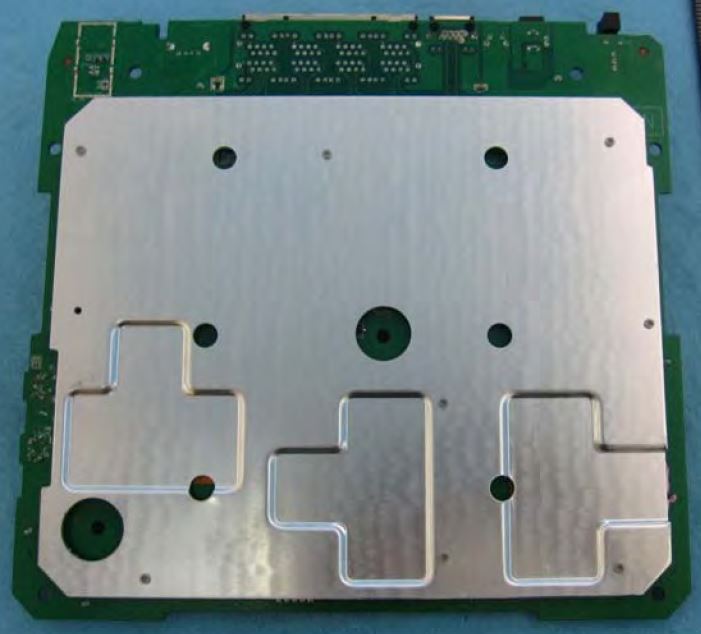
The board bottom is covered almost completely with a heatsink plate. Almost all the bottom of the case is holes to get air to it.
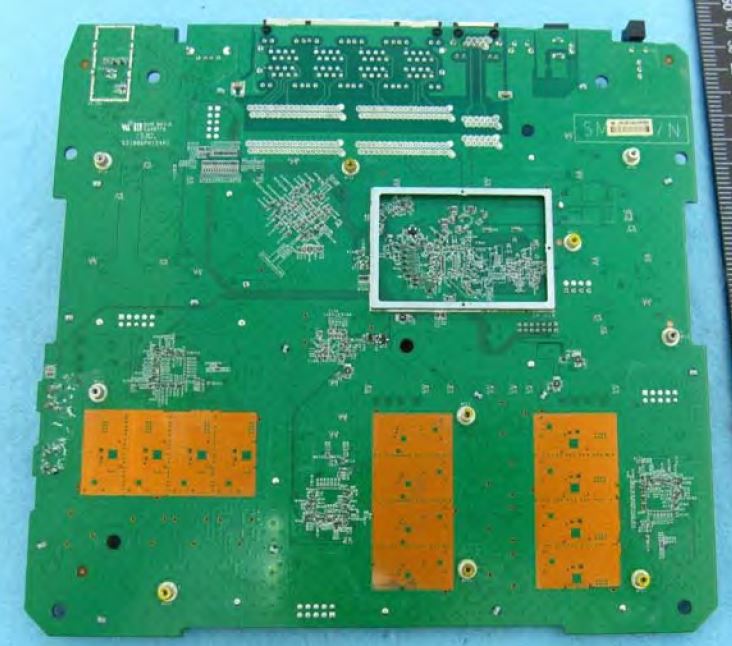
Nothing to see here but thermal pads under the radios and passive components under the CPU section.
Features
The EA9500’s has Linksys’ standard "Smart Wi-Fi" feature set. The main dashboard shown below is the same found on other Smart Wi-Fi routers.
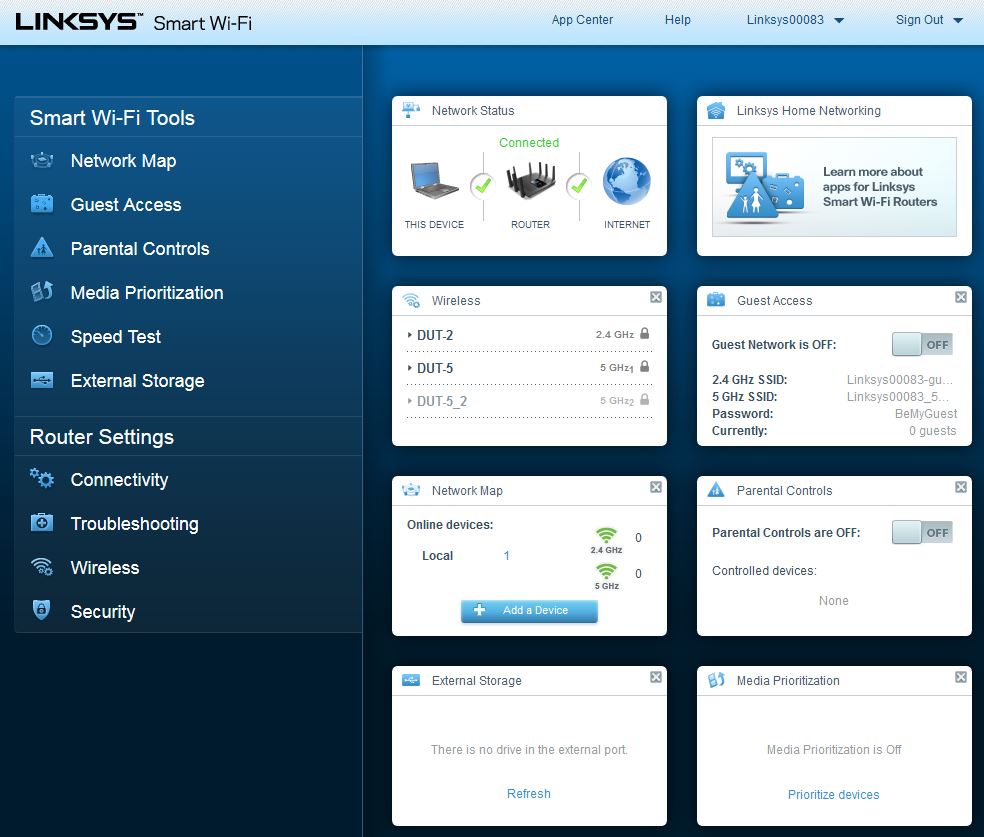
Smart Wi-Fi Dashboard
Linksys’s routing features continue to lag far behind ASUS and somewhat behind NETGEAR’s. The WRT1900AC review contains an accurate summary of the Smart Wi-Fi feature set and also its shortcomings. I won’t belabor this point.
The default wireless settings are shown in the next screenshot. Note "Smart Connect" band-steering is supported only between the two 5 GHz radios, the same as on the 3×3 tri-radio EA9200.
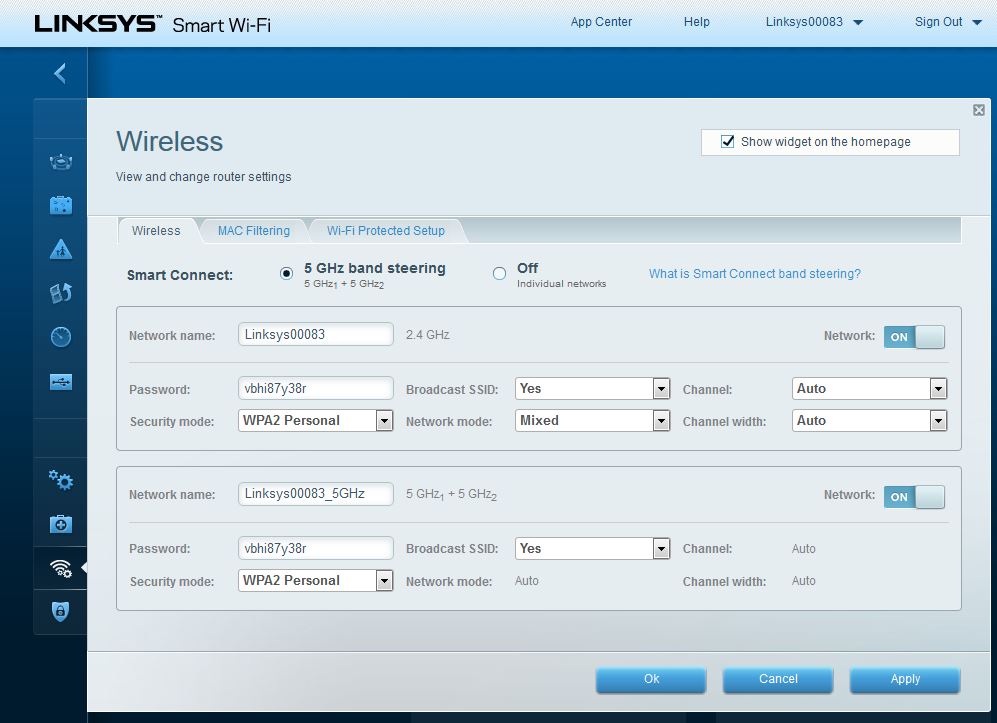
Wi-Fi Defaults
Turning off 5 GHz band steering unlocks all 5 GHz radio controls and exposes 5 GHz high-band controls. The settings shown below have been changed from the defaults.
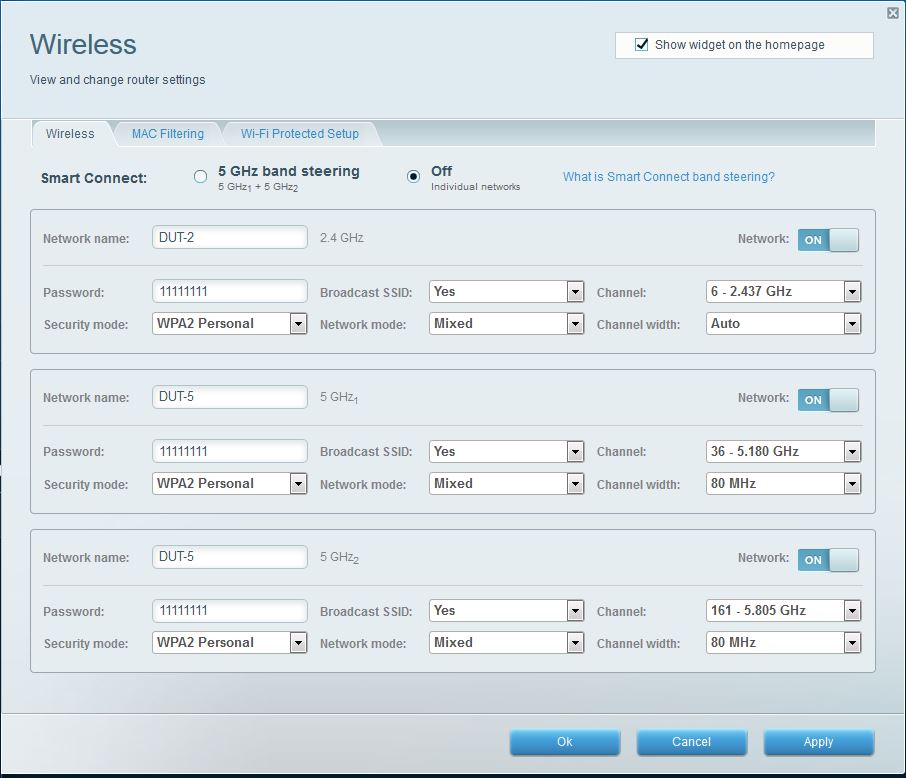
5 GHz band steering disabled
Replacing home.html with advanced-wireless.html in the admin URL shows the 2.4 GHz…
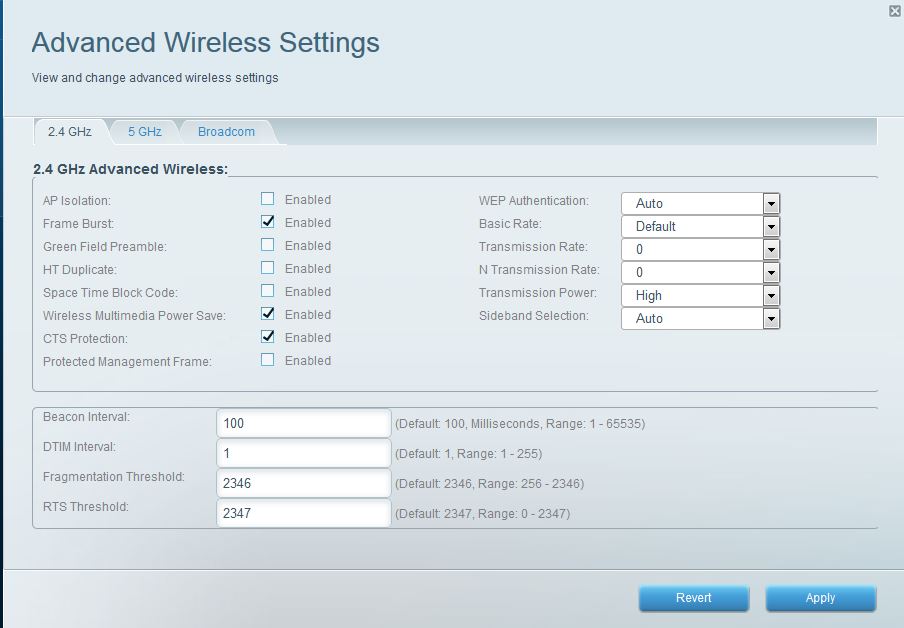
2.4 GHz advanced wireless settings
…5 GHz…
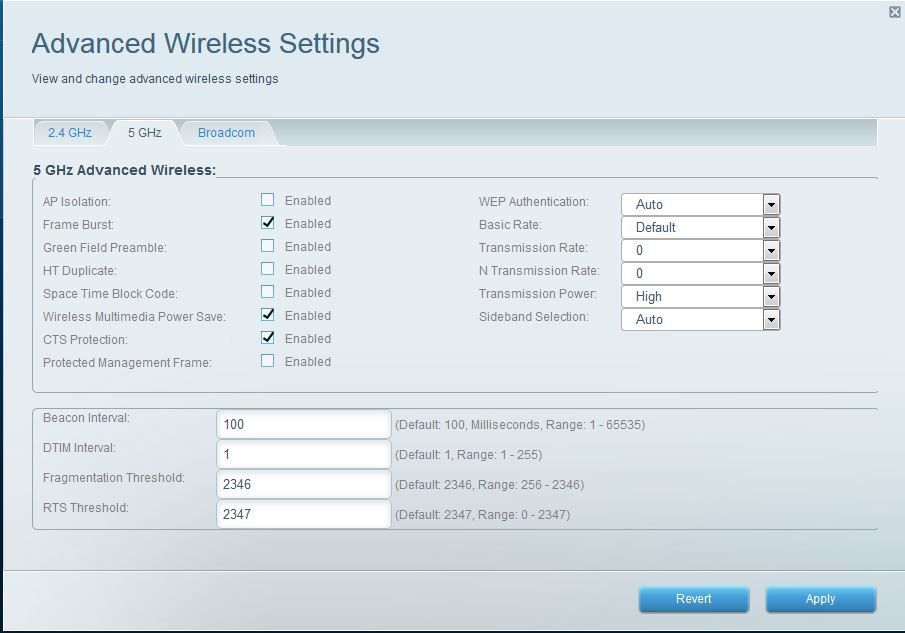
5 GHz advanced wireless settings
…and Broadcom advanced wireless screens. MU-MIMO is enabled on both low and high band radios. Linksys advised, however, that only four MU-MIMO devices are supported with the initial firmware release (2 per radio). We’ll dig into this more when we look at MU-MIMO performance.
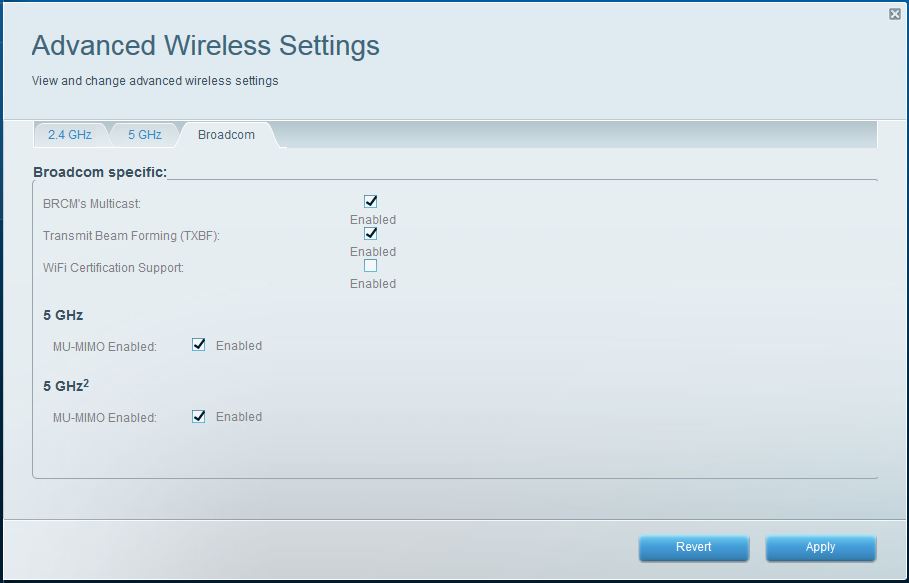
Broadcom advanced wireless settings
The advanced wireless settings include transmit power and transmission rate settings that could come in handy, but could also mess you up badly. So don’t mess with these unless you know what you’re doing. The Broadcom screen controls are interesting. I’ll let you know if Linksys explains the WiFi Certification support settting and why it’s disabled by default.
The MU-MIMO disables could come in handy. Apparently some folks don’t like their Samsung Galaxy S7’s falling back to 1×1 mode when they connect to a MU-MIMO enabled router. Not helpful if you have only one MU-MIMO enabled device. It would have been nice to see airtime fairness enables here, too.
Still missing are timed wireless radio scheduling and wireless bridge or wireless repeating modes.
Storage Performance
We used our standard router storage test procedure to measure file copy throughput for FAT32 and NTFS volumes connected via USB 2.0 and 3.0. I’ll compare NTFS with USB 3.0 performance since that’s what most people will want to use for maximum performance.
The EA9500’s write performance isn’t anything special for either drive format, at just below 30 MB/s for write and 34 MB/s for read. But the other AC5300 routers aren’t establishing new performance heights, either. None come close to the Marvell-powered Linksys AC1900 class WRT1900ACS that runs the same benchmarks at 106 MB/s write NTFS.
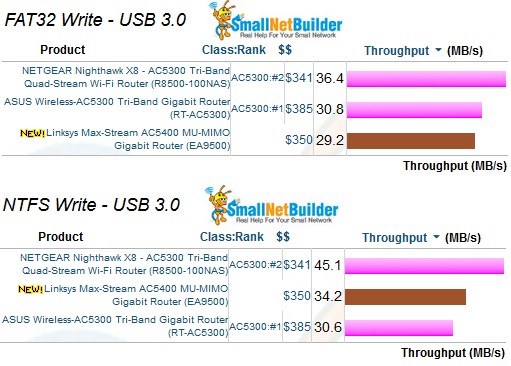
USB 3.0 storage write performance – USB 3.0
Read performance shows more difference among the products, with the EA9500 smack in the middle for both formats. Best performer for NTFS read is again the WRT1900ACS at 96 MB/s.
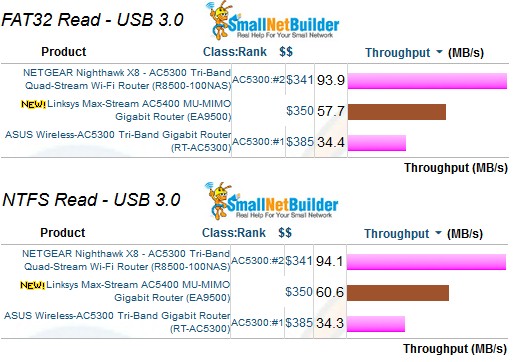
USB 3.0 storage read performance – USB 3.0
Routing Performance
The EA9500 was tested with our new V4 router test process, loaded with 1.1.5.172212 firmware. You can download an Excel test summary that contains all functional and performance test results.
Table 2 summarizes the performance test results. So we have something to compare, I retested two AC5300 class routers, NETGEAR’s R8500 Nighthawk X6 and ASUS’ RT-AC5300.
TCP/IP unidirectional benchmark results are all within striking distance of each other, with the EA9500 the lowest in each case by around 20 Mbps. Simultaneous TCP/IP performance drops somewhat, but is still a respectable 1524 Mbps.
The EA9500’s UDP performance is slightly better than its TCP/IP. But the other two routers’ performance falls by about 50%. If you download the test summaries for the R8500 and RT-AC5300, you’ll see UDP losses between 40 and 60%. Worst case UDP packet loss for the EA9500 ran slightly above 9%.
| Test Description | Linksys EA9500 | NETGEAR R8500 | ASUS RT-AC5300 |
|---|---|---|---|
| WAN – LAN TCP (Mbps) | 918 | 930 | 931 |
| LAN – WAN TCP (Mbps) | 917 | 935 | 938 |
| Total Simultaneous TCP (Mbps) | 1524 | 1593 | 1641 |
| TCP Connection | Pass | Pass | Pass |
| WAN – LAN UDP (Mbps) | 950 | 450 | 420 |
| LAN – WAN UDP (Mbps) | 947 | 361 | 350 |
| Total Simultaneous UDP (Mbps) | 1721 | 1090 | 880 |
| UDP Connection | Fail | Pass | Fail |
| Functional Score (%) | 95.1 | 89.0 | 90.6 |
Table 2: Routing performance comparison
The V4 router test process does away with the Maximum Simultaneous connection test. Instead, we test whether the router can open 3,000 TCP/IP connections and then 3,000 UDP connections. Each connection is verified as it is established and verified again after all 3,000 connections have been opened. This test is tougher to pass than the Maximum Simultaneous connection, because connections must remain open longer.
The EA9500 passed the TCP connection test, but failed the UDP test, a result that seems the norm for all but NETGEAR routers. Once again, the NETGEAR was the only router in the group to pass the UDP connection test.
The Functional Score of 95.1% equates to 12 failed functional tests; the best we’ve seen any router do so far.
Key takeaways from the failed tests are:
- Deprecated HTTPs SSL protocols were not blocked
- Hairpin NAT translation for TCP/IP and UDP are not supported
- Triggered port forwarding tests failed (see below)
- A few minor failures in IPv4 packet forwarding
I’ve yet to find a router that can pass the CDRouter triggered port test, which requires a single port and port range to be opened by a single trigger. The EA9500 allows only a single rule using the same trigger port and opens only a single port range, so failed the test.
The EA9500 did an excellent job on the DNS tests, failing not a single one.
Two port forwarding tests (cdrouter_vservice_30 and cdrouter_vservice_40 if you’re checking the test summary) expect the source IP of the forwarded port to be the router’s WAN IP address. I’m finding not all routers do this and use the LAN IP address instead. The two tests check the TCP and UDP forwarded ports and either both pass or fail. For the EA9500, the UDP test passed, but the TCP test failed, which I thought was odd.
Wireless Performance
The EA9500 was tested with our new Revision 9 wireless test process with 1.1.5.172212 version firmware. Remember the new test process uses an AC1200 class Intel Dual Band Wireless-AC 8260 card, vs. an AC1900 class NETGEAR R7000 router configured as a wireless bridge. Channel 6 and 20 MHz B/W mode was set for 2.4 GHz and Channel 40 and 80 MHz B/W mode was set for 5 GHz. The router was positioned in the test chamber as shown in the photo below.
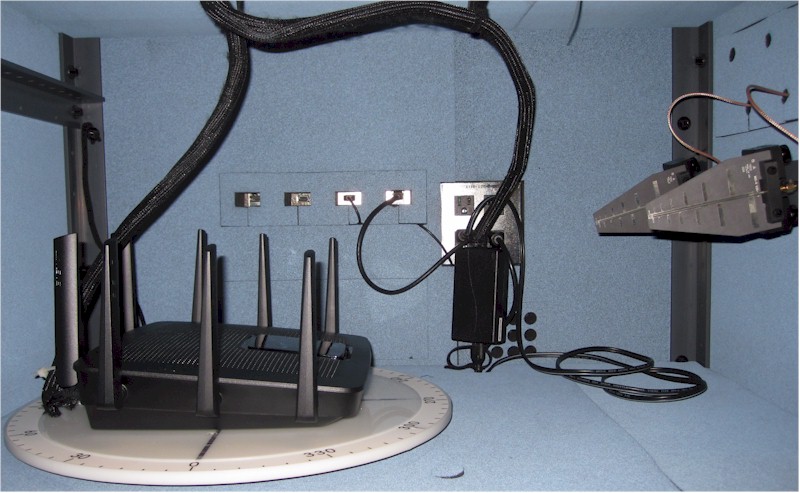
EA9500 in test chamber
As noted earlier, I retested two AC5300 class routers for comparison, NETGEAR’s R8500 and ASUS’ RT-AC5300. Average 2.4 GHz performance is in a relatively narrow range, with the EA9500 smack in the middle of the ASUS on top and NETGEAR on the bottom.
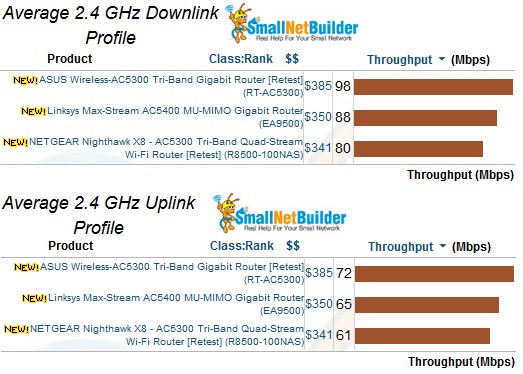
2.4 GHz average throughput comparison
5 GHz averages have a 25 – 30 Mbps difference from best to worst in this three-way comparison. The EA9500 lands in the middle again for downlink, but moves to the bottom for uplink.
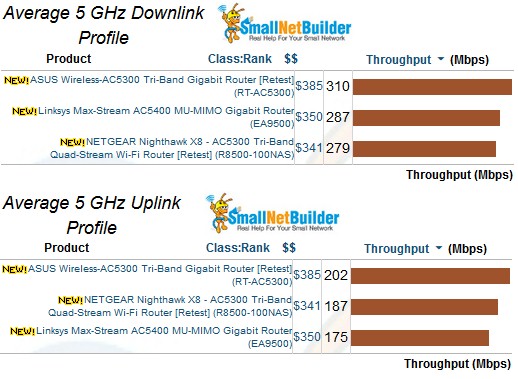
5 GHz average throughput comparison
Wireless Performance – more
The 2.4 GHz downlink throughput vs. attenuation comparison plot provides a better look at performance specifics. The NETGEAR is clearly the inferior performer of the three and the Linksys the best. The EA9500 starts out with high throughput, stays highest the longest and disconnects last.
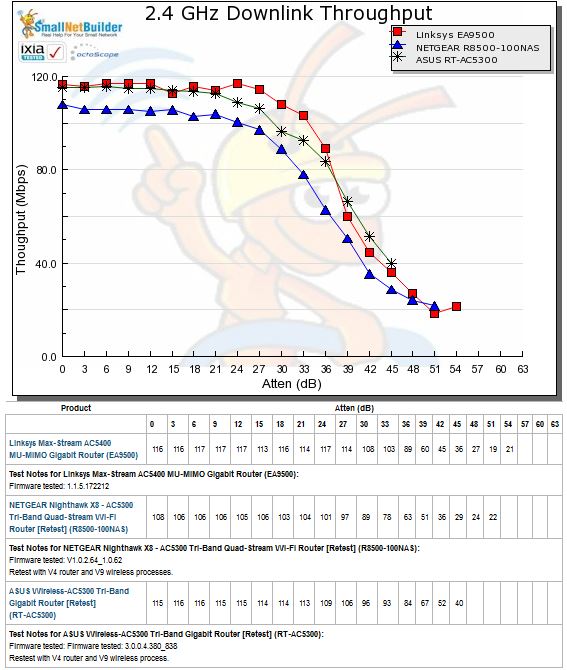
2.4 GHz Downlink Throughput vs. Attenuation
The 2.4 GHz uplink plot shows a similar story for the Linksys, except it runs 2 – 3 Mbps lower than the ASUS in the lower attenuation (higher signal) tests.
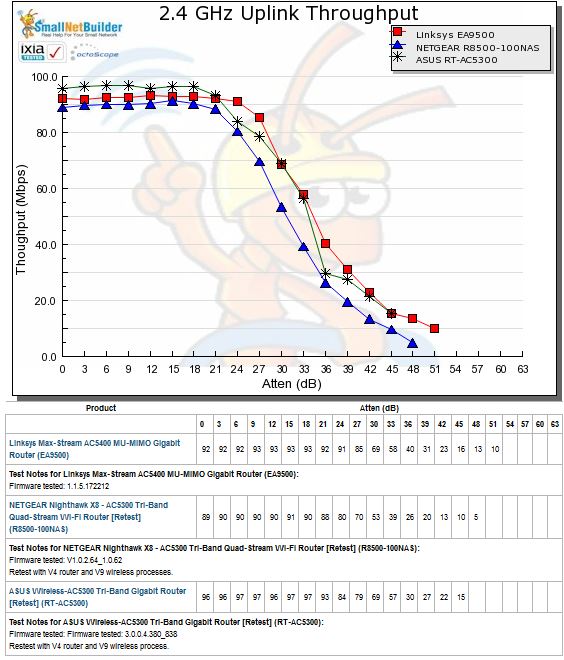
2.4 GHz Uplink Throughput vs. Attenuation
The 5 GHz downlink profile shows very closely matched performance for the three routers from 18 dB of attenuation up. I don’t know how or why the ASUS had over 500 Mbps throughput in the 0 dB test, but it was repeatable over two tests. But throughput quickly fell into line with the other two routers from there on.
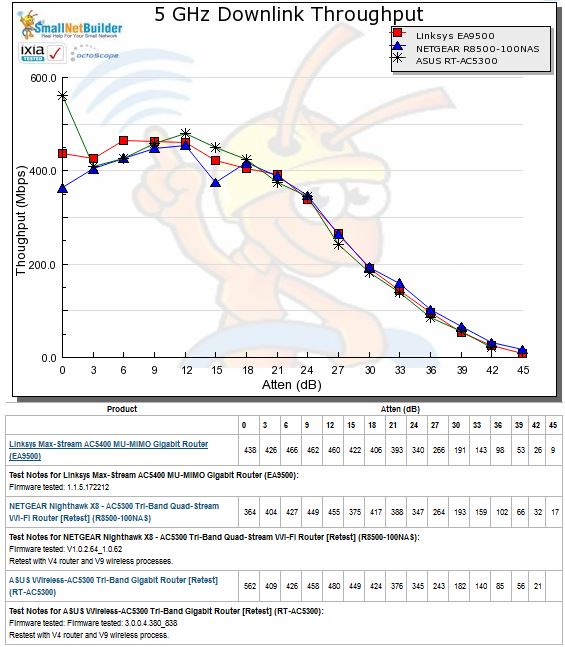
5 GHz Downlink Throughput vs. Attenuation
For 5 GHz uplink, there is not much to say except the three products perform essentially the same for this benchmark.
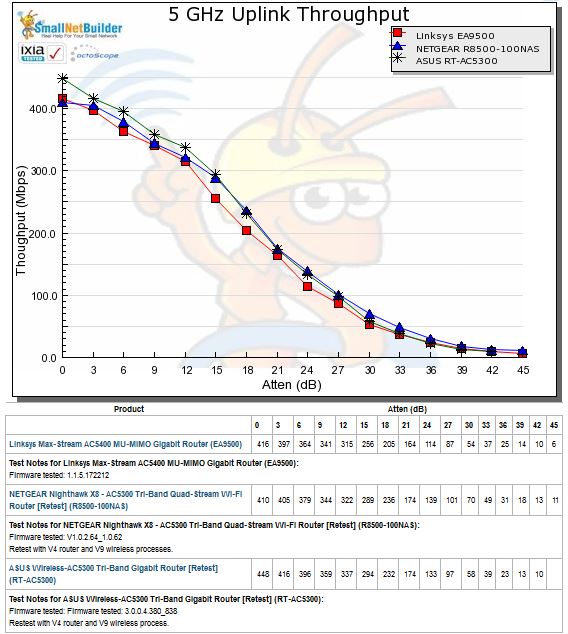
5 GHz Uplink Throughput vs. Attenuation
In all, the performance of these three AC5300 routers is as similar as you might expect for products using basically the same design. I don’t see a reason to recommend one over another on the basis of wireless performance.
Maximum Wireless Throughput
Throughput vs. attenuation plots are now done with a 2×2 STA. So we use the Ixia Veriwave that can emulate up to 4×4 ac devices to test maximum wireless throughput. Note the Veriwave does not support non-standard modulation, which includes 1024 QAM in 5 GHz and 256 and 1024 QAM in 2.4 GHz. So these results represent the equivalent of testing with an AC2350 class wireless bridge with maximum link rates of 600 Mbps in 2.4 GHz and 1733 Mbps in 5 GHz. The results posted are an average of 10 one minute test runs.
2.4 GHz results show the three products in a fairly tight range. Note maximum theoretical throughput reported by the Veriwave for these tests (both up and downlink) is 451 Mbps.
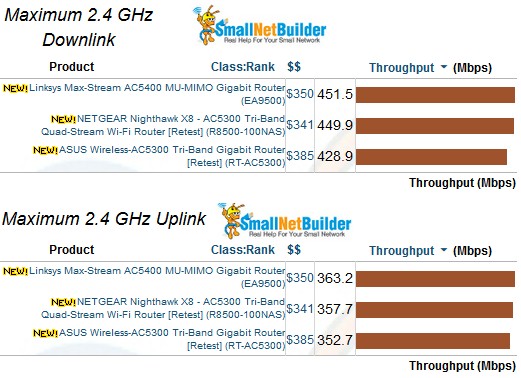
2.4 GHz Maximum Wireless Throughput comparison
Throughput spread is greater for 5 GHz with the Linksys turning in the lowest results of the group. The reason is probably that I could only get the test to run by dropping the MCS rate to 6 (1170 Mbps) for the Linksys. In contrast, the ASUS turned in best performance at MCS 7 (1300 Mbps). Only the top-performer in this test, the NETGEAR R8500, was able to connect at the maximum MCS9 (1733 Mbps). However, I had to run the test on Channel 153 with the NETGEAR; it would not connect using Channel 40.
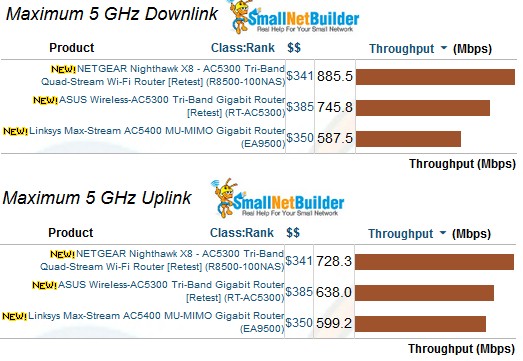
5 GHz Maximum Wireless Throughput comparison
Why No Router Ranking?
With the major changes to our router test methodology, the ranking criteria also must change. Unfortunately, the current version of the Ranker supports only one set of ranking criteria per product class. We’re hard at work on a completely revamped Charts system that will support multiple sets of ranking criteria and test data that will make everything right again. Please bear with us in the meantime.![]()
MU-MIMO
As noted in the opening, the EA9500 is the first 4×4 Broadcom router to support MU-MIMO in official factory firmware. Linksys does provide a caveat that only two MU-MIMO clients are supported per radio, however. Since MU-MIMO routers don’t just stop supporting MU-MIMO devices as more are added (as our tests show), this is an odd statement. But I take it to mean the EA9500’s MU-MIMO is a work in progress and will be improved with a future firmware update.
Linksys was kind enough to provide four of its WUSB6100M Max-stream AC600 Wi-Fi Micro USB Adapters for MU-MIMO testing. But they’re still in the box. I instead ran our standard MU-MIMO test process using the Ixia Veriwave system. The Veriwave requires cabled connection to the router under test’s radios, so I had to pop the top and use pigtails to connect to the teenier-tinier IPEX MHF4 connector that seems to have replaced the just plain tiny U.fl antenna connector. I lucked out with the more accessible placement of the 5 GHz low-band radio’s connectors and didn’t have to remove a heatsink plate to get at them.
Since the EA9500 is a 4×4 MU-MIMO router, it’s fair to compare it to other 4×4 routers with working MU-MIMO, most of which are AC2600 class. I know I repeat myself, but there are no other AC3100 class or AC5300 class routers that support MU-MIMO.
It’s also worth noting the Veriwave emulates standard 1×1 MU-MIMO STAs with 433 Mbps maximum link rates vs. the 866.7 Mbps the EA9500 is allegedly capable of using 1×1 1024 QAM. But since the same STA is used on all products, it’s a fair comparison.
I decided to let the chart include the 3×3 Linksys EA7500 MU-MIMO router, mainly because it beats the 4×4 EA9500. The odd-duck AC2200 class ZyXEL NBG6815 is fairly included because it has a 4×4 5 GHz radio.
With all that said, the EA9500’s average MU-MIMO throughput of 319 Mbps places it third up from the bottom of the chart.
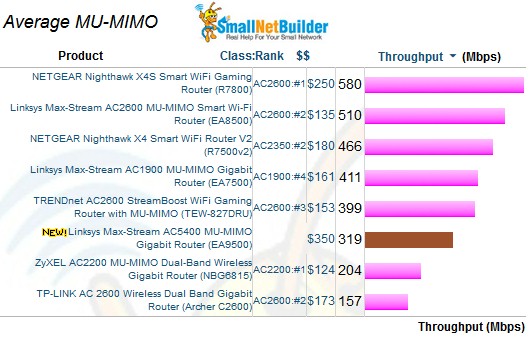
MU-MIMO Average Throughput comparison
SU (single user) MIMO tests show how efficent routers are at serving multiple STAs. Ideally, total throughput should be divided among active STAs, with none lost. This benchmark is also good for showing MU-MIMO routers that are likely to misbehave when dealing with multiple non MU-MIMO clients. Although the EA9500 is on the low side, its 313 Mbps average throughput doesn’t indicate trouble as bad as the ZyXEL and TP-LINK Archer C2600’s numbers do.
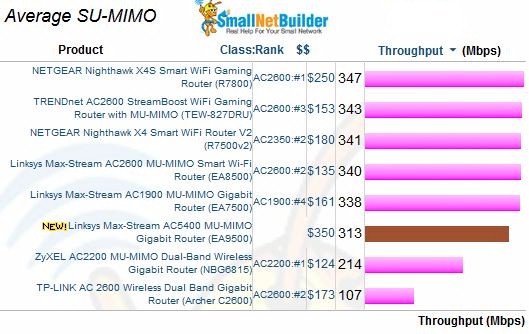
SU-MIMO Average Throughput comparison
The MU, SU Throughput Difference lets you quickly zero in on products with better MU-MIMO throughput gain. The EA9500’s result of 6 means it doesn’t provide much more throughput with the 16 STAs used in the test than a non MU-MIMO router would.
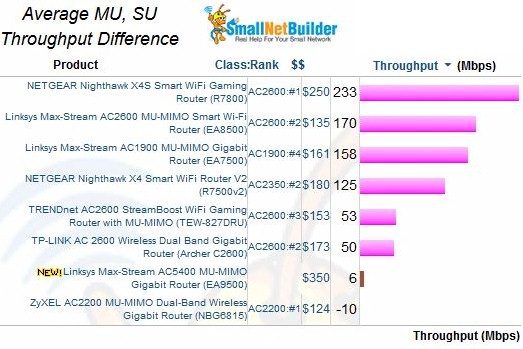
Average MU, SU Throughput difference
The MU, SU Difference vs. STA plot can get messy. So I just included the QCA based Linksys EA8500 for comparison. The EA8500’s plot shows peak throughput gain of 370 Mbps with six STAs. The EA9500’s throughput gain peaks at only 151 Mbps with three STAs, then falls off rapidly to move to a throughput loss from 7 STAs up.
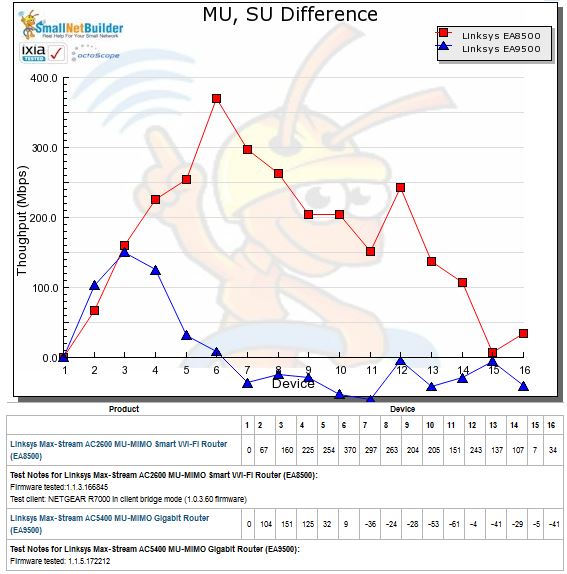
MU, SU Throughput difference
The SU-only comparison shows the problem isn’t with SU throughput, which has the gradual decline typically seen. The main problem is MU performance, which, as Linksys knows, still needs more work.
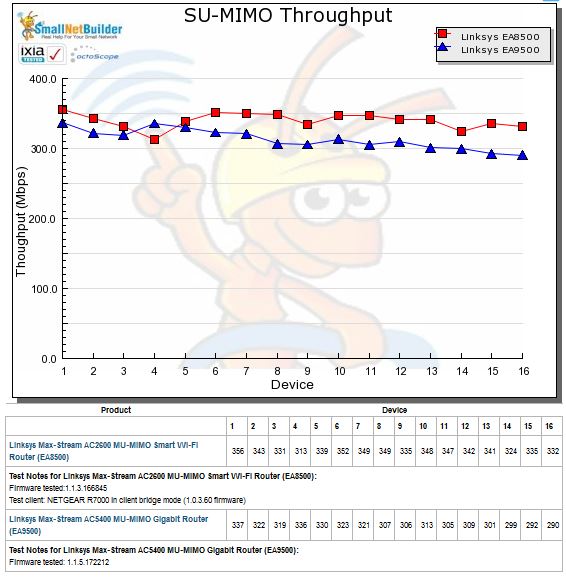
SU Throughput vs. STA
Closing Thoughts
I apologize for not testing Smart Connect performance for the EA9500. The new test processes take a lot more time and with the retesting required to provide comparison products for the charts, I’m having to make hard choices about what not to test. Fear not, band-steering and load balancing testing is still on the radar. I just need to make it more automatic than the manual process I’ve been using.
At any rate, the testing I have done shows the EA9500’s wireless performance very similar to last year’s crop of AC5300 routers. The EA9500’s main differentiation at this point, aside from the lets-keep-em-confused AC5400 moniker, is its lone-wolf status as a Broadcom-based router that has working MU-MIMO. In the end, this is just another really expensive router that’s unlikely to light up any of your pesky dead spots or handle a large number of devices any better than a much cheaper AC3200 class tri-radio alternative.
